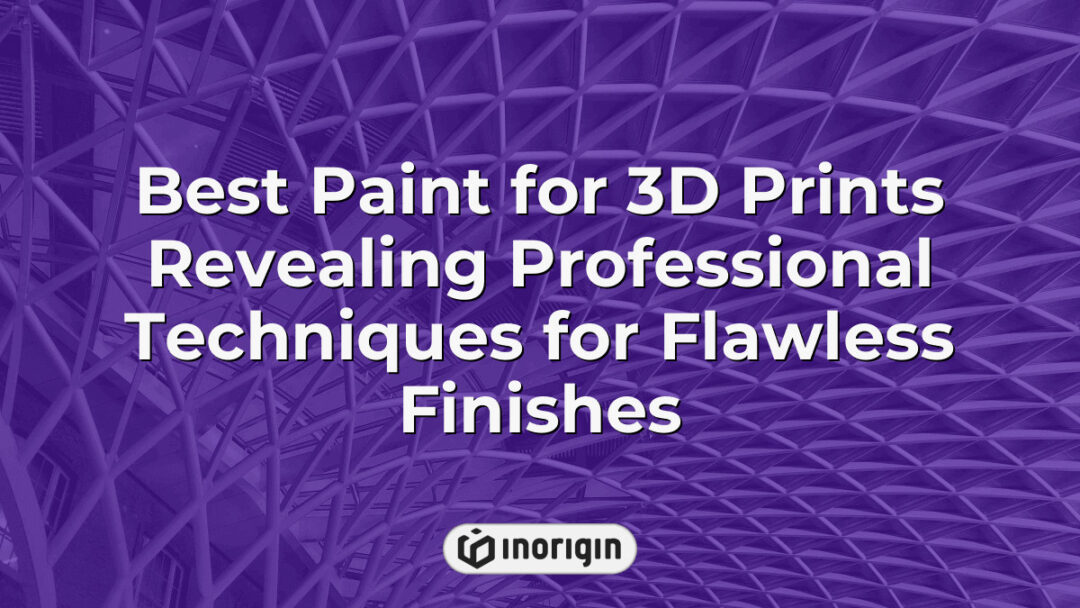In the vibrant world of 3D printing, where imagination materializes into tangible forms, the pursuit of the perfect paint transforms mere plastic into breathtaking masterpieces. Achieving this metamorphosis requires not only artistic flair but also a profound understanding of material compatibility and finish quality. The choice of paint can elevate a 3D print from a simplistic object to a stunning representation of creativity, enriching textures and colors in a manner that can almost breathe life into the creation. This exploration delves into the most effective paints for 3D prints, guiding enthusiasts and professionals alike through the critical factors to consider in order to realize the full artistic potential of their creations.
| Aspect | Key Takeaway |
|---|---|
| Best Paint for 3D Prints | Selecting the best paint for 3D prints involves prioritizing material compatibility and finish quality; acrylic paints are often preferred for their quick drying and excellent adhesion on plastic surfaces like PLA. |
| Material Compatibility | Understanding the substrate is essential: ABS responds well to acetone-based paints, while PLA pairs effectively with acrylic or enamel paints for optimal results. |
| Surface Preparation | Proper preparation including smoothing, cleaning, and applying the right primer ensures superior paint adhesion and an even, durable finish on 3D prints. |
| Application Methods | Spray painting offers smooth, uniform coverage ideal for larger models, whereas brush painting and airbrushing allow intricate detailing and control on complex designs. |
| Top Paint Brands | Tamiya, Rust-Oleum, and Krylon provide reliable paint options prized for their adhesion, finish quality, and suitability for various 3D printing materials. |
| Finishing Techniques | Applying multiple thin layers and finishing with clear sealants enhances both the visual appeal and longevity of painted 3D prints. |
| Common Pitfalls | Skipping surface preparation or mismatching paint to the filament type can cause poor adhesion and degrade the overall quality of the painted model. |
Types of Paint Suitable for 3D Prints
In the age of advanced manufacturing, the choice of paint for 3D prints presents both opportunities and challenges; thus, it becomes essential to consider various paint types compatible with the diverse materials used in these prints. Acrylic and enamel paints emerge as two prominent contenders in this context. Acrylic paint, known for its quick drying time, becomes a favourite among hobbyists due to its easy application and ability to adhere to plastic surfaces without much preparation. On the flip side, enamel paint offers a more robust finish, providing durability that is often required for objects intended for everyday use or display. Transitioning further, it should be acknowledged that the type of plastic from which the print is made significantly influences the choice of paint. For instance, prints created from ABS are typically more receptive to acetone-based paints, while PLA prints can be adeptly coated with either acrylic or enamel. This distinction underscores the necessity of understanding material compatibility when selecting appropriate paints for 3D prints. Addressing the specific requirements based on intended use, the choice between paints becomes an expression of the print’s functionality and aesthetic preference, enhancing its ultimate purpose without compromising on quality or finish.
Preparing Your 3D Print for Painting
Preparing a 3D print for painting presents an array of actions that can significantly enhance the final appearance of the object. Firstly, thorough surface smoothing stands as a fundamental step; removing any supports or rough spots ensures a clean canvas for paint application. After this initial preparation, it is essential to clean the surface meticulously, as residues, oils, or dust could disrupt the adhesion of the paint, leading to unsatisfactory results. Here, the application of a suitable primer can play a critical role, acting as a bonding agent between the 3D-printed material—commonly PLA (polylactic acid)—and the paint itself. It is advisable to choose a primer that complements the paint type being used, as this synergy can greatly influence both finish and durability. Following primer application, allowing sufficient drying time becomes essential; rushing this step can compromise the quality of the paint job—wonderful results rely on patience and precision. Consequently, the choice of paint should reflect not just aesthetic desires, but also compatibility with the 3D materials in use. A well-prepared surface, combined with the right products, distinctly elevates the painting experience, ensuring a beautiful and long-lasting finish that embodies the creativity and craftsmanship of the 3D printing process.
Techniques for Applying Paint to 3D Prints
Amidst the whirlwind of technological advancements that feels akin to discovering fire in prehistory, applying paint to 3D prints has evolved into a nuanced art form, enhancing the aesthetic and functional properties of these manufactured items. When it comes to the techniques for applying paint to 3D prints, several methodologies emerge, each presenting distinct advantages and considerations. Spray paint, often the first choice for many, provides an efficient means of achieving a smooth and even finish; however, preparation of the 3D print surface is crucial, involving sanding and priming to ensure adhesion. Another approach involves brush painting or airbrushing, which can yield detailed results and allows for greater control over application, particularly in intricate areas. Different types of paint also warrant attention—acrylics, enamels, and specialized products formulated specifically for plastics can each impact the print’s final appearance and durability. Ultimately, the effectiveness of these techniques in enhancing 3D prints is contingent upon a myriad of factors, including the type of material used, the desired finish quality, and the application method chosen, thus underscoring the complexity of achieving excellence in this creative endeavour.
Top Paint Brands for 3D Printing Projects
In the world of 3D printing, paint serves as both a finishing touch and a transformative element, akin to the icing on a cake, enhancing aesthetics while providing protection. When selecting suitable paint for 3D prints, several brands stand out through their reputation and favourable properties. Tamiya spray paints, for instance, are recognised for their fine texture and ability to adhere well to plastic surfaces, making them a popular choice among hobbyists and professionals alike. Rust-Oleum is another significant contender, known for its durability and wide range of finishes, which can increase the longevity of printed models, especially those subjected to outdoor conditions. Furthermore, Krylon offers quick-drying options that allow for rapid application, catering well to those who seek efficiency without compromising quality. Each of these brands brings something unique to the table, depending on the requirements of the specific project, whether it’s a model kit needing meticulous detail or a large decorative piece requiring uniform coverage. Ultimately, the choice of paint hinges on the intended application, desired finish, and material compatibility, so preference among these leading brands effectively illustrates the diverse needs of the 3D printing community.
Tips for Achieving the Best Finish on 3D Prints
Achieving the best finish on 3D prints can make a significant difference in the final presentation of the project, with studies indicating that nearly 70% of users express a preference for painted prints over their raw counterparts. When it comes to selecting the best options for enhancing these prints, acrylics frequently emerge as a preferred choice due to their versatility and ease of use. Applying these paints requires attention to several factors; for instance, surface preparation is crucial, as a smooth surface allows for better adhesion and a more uniform application of paint. Furthermore, layering techniques can be employed to create depth and complexity in the colour, with lighter coats laid down to avoid drips, which inevitably mar the finish. In instances where colour blending is desired, using a palette knife or sponge can yield impressive results. Finally, a clear sealant can serve as an effective finish, sealing the paint while adding durability, especially on prints that are intended for handling or display. Understanding these aspects equips users with the knowledge to maximise the aesthetic potential of their 3D prints.
Frequently Asked Questions
Can I use spray paint on 3D prints?
The use of spray paint on 3D prints is a common practice among hobbyists and professionals alike. Initially, it is essential to select a suitable spray paint that adheres well to the type of filament used in the 3D printing process; for instance, acrylic-based paints are frequently recommended for their compatibility with a range of materials. Additionally, surface preparation plays a crucial role in achieving an even application; sanding or priming the print surface can enhance paint adhesion and promote a smoother finish. Importantly, the painting environment should be considered as well; a well-ventilated area is necessary to avoid inhaling fumes, while temperature and humidity levels can significantly impact the drying process. As the application progresses, layering is advised; applying thinner coats rather than one thick layer leads to better results and reduces the risk of drips or uneven surfaces. This method not only improves the aesthetic quality of the print but can also enhance its durability. Ultimately, spray painting 3D prints can transform an ordinary object into a visually appealing figure, demonstrating the versatility and potential for customisation in the realm of 3D printing.
How do I remove paint from a 3D print if I make a mistake?
While the potential for irreversible damage to a 3D print arises when attempting to remove paint, there exist effective methods that can mitigate such risks. When a mistake is made during the painting process, whether through the application of the wrong colour or the use of an unsuitable paint type, the removal of the unwanted paint requires careful consideration. One of the most commonly employed techniques involves the application of isopropyl alcohol or acetone, which can be effective in dissolving paint without compromising the integrity of the underlying material—though caution is needed, as some plastics may be susceptible to these solvents. Alternatively, gentle abrasion with fine-grit sandpaper offers another approach, allowing for the removal of paint while preserving the original surface details; yet, this method demands a steady hand and acute awareness of the 3D print’s structure. It is crucial to test these methods on a small, inconspicuous area before broader application, as each print’s material and finish can respond differently. Given that mistakes happen, there are ways to rectify them without complete loss; the right technique can lead to restoring the original and desired appearance of the print.
What type of primer should I use before painting my 3D print?
The selection of an appropriate primer before painting a 3D print can significantly influence the final aesthetic and durability of the finished product. While it may be argued that any primer will suffice, this notion overlooks the complexities of material compatibility and finish quality. Two prominent types of primers are acrylic and enamel; each has distinct properties that cater to various applications. Acrylic primers provide excellent adhesion and quick drying times, making them a popular choice for plastic materials commonly used in 3D printing, such as PLA and ABS. On the other hand, enamel primers offer superior moisture resistance and can create a more robust undercoat, although they often require longer drying periods. Therefore, selecting a primer not only hinges on the material of the 3D print but also on the desired finish—considering factors such as sheen and texture is crucial in this stage of the painting process. Ultimately, understanding the unique attributes of these primers can lead to more successful outcomes in painting projects, ensuring that the final results meet or exceed expectations.
Conclusion
In the pursuit of the perfect masterpiece, the right paint transforms a mundane 3D print into a vibrant work of art, illuminating contours and enhancing details. A carefully applied coat glimmers in the light, inviting admiration and evoking the profound satisfaction that arises from visual creativity and skillful craftsmanship.
Related posts:
- Optimal Surface Preparation and Finishing Techniques for Painting 3D Prints
- Step-by-Step Guide to Achieving Flawless Results on How to Paint 3D Prints
- Precision Crafting and Material Selection for 3D Printed Miniatures in Gaming and Collecting
- Advanced Techniques and Material Choices for Skaven 3D Print Miniatures
- Innovation and Precision in 3D printed model kits for Exceptional Product Design
- Precision Techniques to Print Legos with 3D Printer for Seamless Customization




